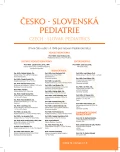Cri du chat syndrome in the newborn diabetic mother
Authors:
T. Šrámková 1; J. Nikolinyová 1; T. Baška 2; D. Kantárska 3
Authors‘ workplace:
Novorodenecká klinika SZU, Fakultná nemocnica s poliklinikou F. D. Roosevelta, Banská Bystrica
1; Ústav verejného zdravotníctva, Jesseniova lekárska fakulta v Martine, Univerzita Komenského
v Bratislave, Malá Hora
2; Oddelenie lekárskej genetiky, Fakultná nemocnica s poliklinikou F. D. Roosevelta, Banská Bystrica
3
Published in:
Čes-slov Pediat 2017; 72 (3): 182-186.
Category:
Case Report
Overview
Cri du chat syndrome, also known as Lejeune's syndrome is a genetic disorder due to a deletion of chromosome 5. The condition is characterized by the typical high-pitched cry, which is similar to that of a meowing cat, dysmorphic features, slow weight gain and delayed development. In 10–15% of cases one of the parents is a carrier of a chromosomal abnormality. In 80% of cases, de novo mutations occurs. In the case study, Cri du chat syndrome occured in a girl with healthy parents, with de novo mutation. Her mother was diagnosed with gestational diabetes mellitus (GDM) during her pregnancy. GDM discovered during gravidity can be previously undetected diabetes mellitus type 2. (DM). The complications which occur at newborn babies of mothers with DM can differ depending on the treatment their mothers have and the standards of the glucose levels, prenatal and perinatal. Fetal harm can be very serious looks like as embryo and fetopathy. It is questionable if untreated diabetes can cause changes on the chromosome level.
Key words:
Cri du chat syndrome, gestational diabetes mellitus, newborn
Sources
1. Gu H, Jiang JH, Li JY, et al. A familial Cri-du-chat/5p deletion syndrome resulted from rare maternal complex chromosomal rearrangements (CCRs) and/or possible chromosome 5p chromothripsis. PLoS One 2013; 8 (10): e76985.
2. Šašinka M, Šagát T, Kovács L, et al. Pediatria. 2 vyd. Bratislava: Herba spol. s.r.o., 2007 : 1–1450.
3. Sheth F, Gohel N, Liehr T, et al. Gain of chromosome 4qter and loss of 5pter: An unusual case with features of Cri du chat syndrome. Case Report in Genetics 2012; 2012 (2012): ID 153405 : 4.
4. Dangare HM, Oommen SP, Sheth AN, et al. Cri du chat syndrome. A series of five cases. Brief Communication 2012; 55 (4): 501–505.
5. A.B.C. Asociácia detí so syndrómom mačacieho plaču. Syndróm mačacieho plaču (Lejenuov syndróm). http://www.criduchat.org/files/7814/2473/1930/CriDuChat_SVK.pdf.
6. Zhang B, Willing M, Grange DK, et al. Multigenerational autosomal dominant inheritance of 5p chromosomal deletions. Am J Med Genet Part A 2016; 170 (3): 583–593.
7. Nguyen JM, Qualmann KJ, Okashah R, et al. 5p deletions: Current knowledge and future directions. Am J Med Genet C Semin Med Genet 2015; 169 (3): 224–238.
8. Mainardi P. Cri du chat syndrome. https://ojrd.biomedcentral.com//articles/10.1186/1750-1172-1-33.
9. Caballero AR, Lagares DT, Pérez AR, et al. Cri du chat syndrome: A critical review. Med Oral Patol Oral Cir Bucal 2009; 15 (3): 473–478.
10. Wiedemann HR, Kunze J. Atlas klinických syndrómov pre kliniku a prax. 1. vyd. Martin: Osveta, 1995 : 1–684.
11. Cornish KM, Pigram J. Developmental and behavioural characteristics of cri du chat syndrome. Arch Dis Child 1996; 75 : 448–450.
12. Vestník Ministerstva Zdravotníctva Slovenskej republiky z roku 2011. http://www.health.gov.sk/Zdroje?/Sources/dokumenty/vestniky_mz_sr/vestnik-49-60-2011.pdf.
13. Binder T, Vavřinková B. Těhotná v ordinaci negynekologa. 1. vyd. Praha: Mladá fronta a. s., 2011 : 1–204.
14. Kapraľová R, Mojžiš R, et al. Novorodenec diabetickej matky. Detský lekár 2012; 19 (3): 71–73.
15. Féderová L. Výskyt diabetes mellitus v gravidite na Slovensku v r. 1997–2008. Vedecká konferencia doktoradov LF UK Bratislava. http://svoc.fmed.uniba.sk/abstrakty/49/06.pdf.
16. Pelikánová T, Bartoš V, et al. Praktická diabetológia. 4. vyd. Praha: Maxdorf, 2010 : 4–74.
17. Vašut K, et al. Léčiva v těhotenství. Vliv léků a vitaminů na zdravý vývoj plodu. 1. vyd. Brno: Computer Press, 2007 : 1–112.
18. Kapraľová R, Mojžiš R, et al. Novorodenec diabetickej matky. Detský lekár 2012; 19 (3): 71–73.
19. Nold, JL, et al. Infants of diabetic mothers. Pediatr Clin N Am 2004; 51 : 619–637.
20. Moore LL, Bradlee ML, Singer MR, et al. Chromosomal anoma-lies among the offspring of women with gestationl diabetes. Am J Epidemiol 2002; 155 (8): 719–724.
21. Nečas E, et al. Patologická fyziologie orgánových systémů, část II. 2. vyd. Praha: Karolinum, 2009 : 1–369.
22. Boehm BO, Möller P, Högel J, et al. Lymphocytes of type 2 diabetic women carry a high load of stable chromosomal aberrations. Diabetes 2008; 57 (11): 2950–2957.
23. Mandal A. Diabetic mothers and risk of birth defects in baby: Study. http://www.news-medical.net/news/20120206/Diabetic-mothers-and-risk-of-birth-defects-in-baby-Study.aspx.
Labels
Neonatology Paediatrics General practitioner for children and adolescentsArticle was published in
Czech-Slovak Pediatrics

2017 Issue 3
- What Effect Can Be Expected from Limosilactobacillus reuteri in Mucositis and Peri-Implantitis?
- The Importance of Limosilactobacillus reuteri in Administration to Diabetics with Gingivitis
Most read in this issue
- Patello-femoral disorders in children
- Legg-Calve-Perthes disease
- Pepsin in secretion from the upper respiratory tract as a marker of extraesophageal reflux in children
- RSV infection in late preterm infants
